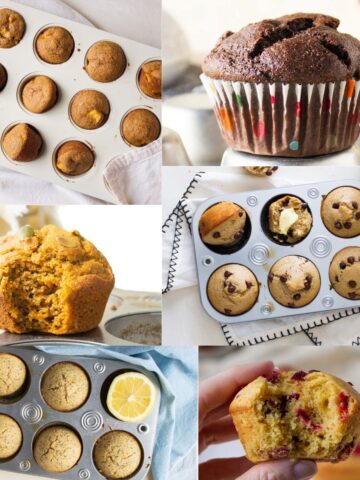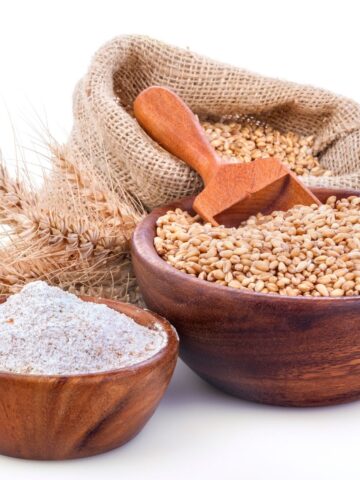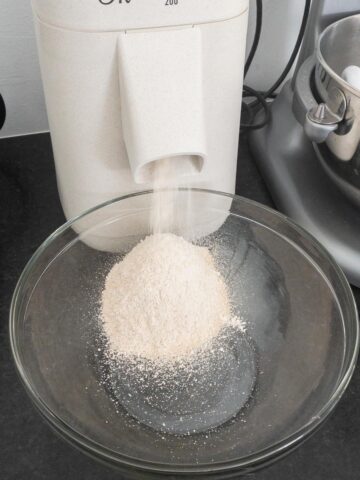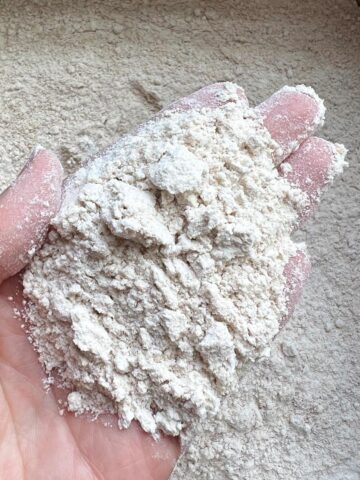Baking with whole wheat flour can be a little tricky. With the right knowledge and a desire to learn anyone can do it with great success. You might be surprised to discover you actually like the results of your baked goods better with whole wheat flour than with all purpose flour. We are going to share 5 mistakes to avoid when you’re baking with whole wheat flour, and help fast track you on your journey to eating healthier.

1. Using the Wrong Type of Flour
Whether you are milling your own flour or buying it. Using flour made from the right type of wheat for your project is important. There are a few different types of wheat, and some are better suited for different baked goods than others. Choosing the right kind for your baking project can make all the difference.
The Three Main Types of Wheat:
- Hard red (whole wheat flour). When you buy regular whole wheat flour it is most likely made from hard red wheat. This wheat has the boldest flavor and also the darkest color. It is best suited for yeast breads that you want to have a nuttier, wheat flavor, such as, an artisan loaf.
- Hard white (whole white wheat flour or white whole wheat flour). This is our favorite, and we use it for most of our baking. It’s like an all purpose whole wheat flour. It comes from the hard white wheat berry, and is great for almost everything, from soft sandwich bread, to muffins, quick breads, and pancakes.
- Soft white (whole wheat pastry flour). This is great if you want a softer, more delicate texture in your baked goods. Whole wheat pastry flour comes from the soft white wheat berry. It is lower in protein than hard white and hard red, therefore does not do well in yeast doughs where gluten formation is required. It is best for baked goods leavened with baking powder or baking soda. Try it in things like pancakes, muffins, cakes, and pie crust.
Just experiment and find what you like best. Some people like to mix different flours to create a balance of flavor and texture that they enjoy. The sky's the limit!
2. Using Too Much Flour
It is important to measure flour properly. Using too much flour can make your baked goods dry, dense, crumbly, and not rise properly. Weighing your flour will give you the most accurate and consistent results. If you don’t have a scale, then use the scoop and level method. When measuring flour: fluff your flour, then scoop your cup full without pressing it against the container, scrape the top off with a straight edge spatula or knife. We use an offset spatula.
Whole wheat flour contains all three parts of the whole wheat berry, the bran, the germ, and the endosperm. It absorbs more moisture than regular all purpose flour which consists only of the endosperm. Thus, you must be careful when substituting whole wheat flour for all purpose flour in recipes.
Weights for Whole Wheat Flours
Hard red wheat flour 1 cup = 136 grams
Hard white wheat flour 1 cup = 128 grams
Soft white wheat pastry flour 1 cup = 120 grams

3. Substituting 1:1 Whole Wheat flour for All Purpose flour
Whole wheat flours typically need more moisture than all purpose flour. The amount of moisture needed also depends on what type of wheat you are using. Hard white wheat will be the closest to all purpose flour and you can usually do a 1:1 swap in muffins, quick breads, pancakes, and waffles. Yeast doughs are the most sensitive and should never be swapped 1:1.
We are working on a guide for converting recipes from all purpose flour to whole wheat flours. Sign up for our emails or follow us on Instagram if you want to know when it comes out.
4. Using Old Flour
One of the most common complaints people have about baking with whole wheat flour is the “bitter taste”. Whole wheat flour should not taste bitter. The bitter taste comes from flour being too old and is starting to go stale. Remember, whole wheat flour contains all three parts of the wheat berry, the bran, the germ and the endosperm. It has a much shorter shelf life than all purpose flour, which is made from only the endosperm. Check the date on your flour and smell it before using, if it smells stale then don’t use it. You can prolong the life of your whole wheat flours by storing them in the refrigerator or freezer. Just bring it to room temperature before using it in your recipes.

5. Expecting an All Purpose Flour Result
Whole wheat baked goods are going to be different from baked goods made with all purpose flour, it’s just a fact. BUT, that does not mean they can’t be good! In fact, a lot of baked goods are superior when they are made with whole wheat flour. All purpose flour is bland, and tasteless, and, not to mention, lacks nutrition. Whole wheat has a nutty flavor, thanks to the bran, and the germ, which gives baked goods a depth of flavor that you will never get from all purpose flour.
If you are wary of using whole wheat flour, but want to start eating healthier, then just start with a little bit. You can replace a small amount of the flour with whole wheat flour in your recipe and gradually work your way to 100% whole wheat flour.

Baking with whole wheat flour does take a learning curve, but we’re here to take the curve out of learning 😁! Once you get the hang of it, there will be no going back. Just start experimenting and see what works for you. We are here to help you along the way. If you have any questions send us an email or a DM on Instagram and we will do our best to help you.
If you found this article helpful it would mean the world to us if you would leave a comment or share it with someone who could benefit from it.







Erin
can I mix whole wheat with almond flour? right now my recipe calls for half whole wheat and half white flour. I'm trying to get rid of the white flour
WholeWheatKitchen
Hi, almond flour is a lot different than wheat flour so we wouldn’t recommend using it in place of the white flour. We would suggest substituting the white flour in your recipe for more whole wheat flour. You will most likely need a little less whole wheat flour than it calls for white flour.